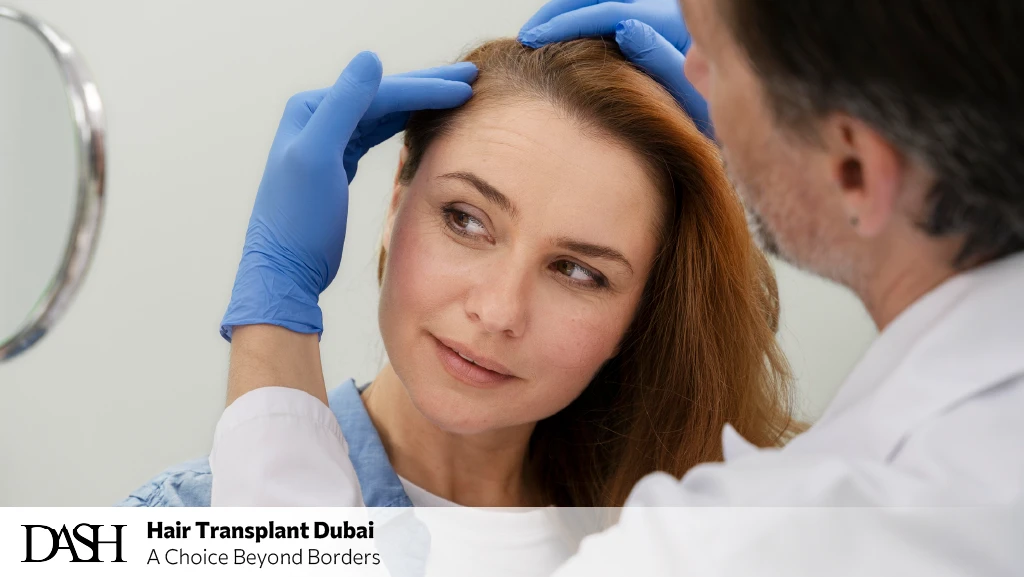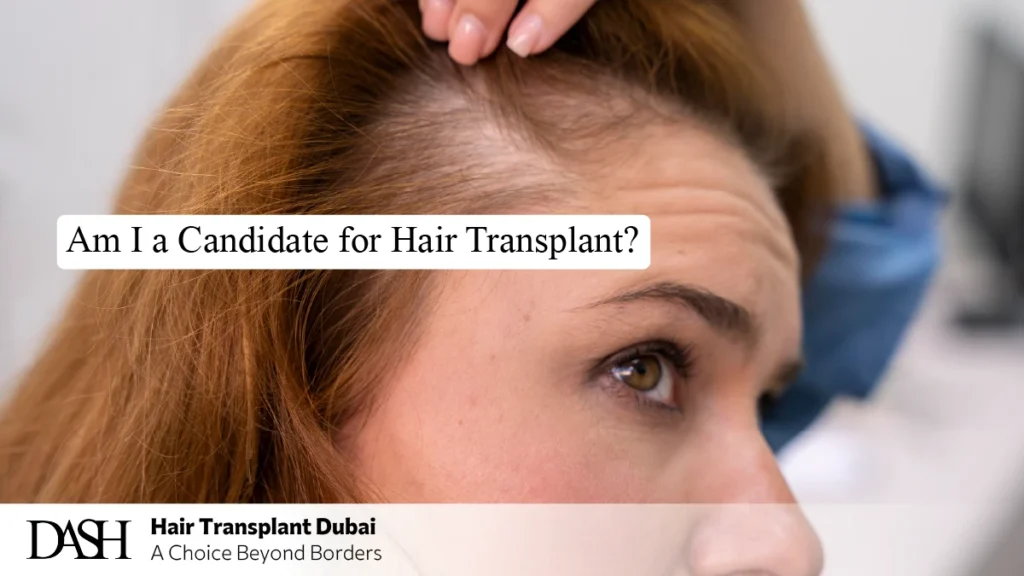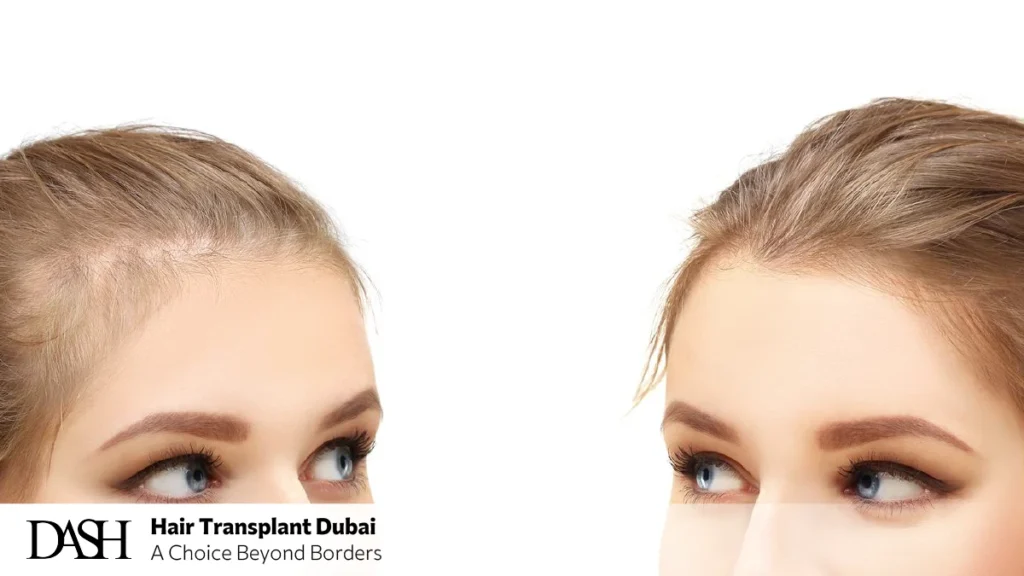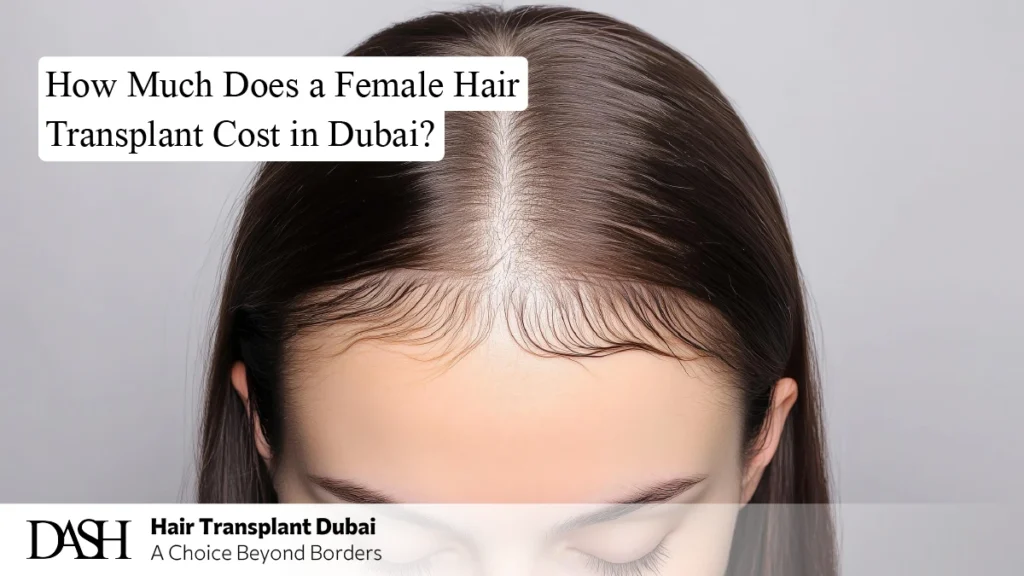Female Hair Transplant in Dubai | Causes, Options & Success Rates

For women, hair isn’t just style—it’s a part of how we express ourselves. It frames our face, holds memories of our best days, and gives us that little boost of confidence when we need it most.
So when hair starts to thin, fall out, or change… it’s more than a beauty issue. It’s emotional.
But here’s the truth: you’re not alone, and more importantly—you’re not out of options.
Today, more women in Dubai are choosing female hair transplant procedures not just to restore hair, but to reclaim a part of themselves. Thanks to modern techniques like FUE and DHI, hair restoration is now more natural-looking, more precise, and more tailored to the unique structure of a woman’s hairline.
Whether you’re noticing a widening part, thinning at the temples, or recovering from stress-related hair loss—this guide is here to walk you through every step with honesty, care, and clarity.
Because your beauty never left—you’re just ready to bring it forward again. ✨
🟣 Section 1: What Causes Female Hair Loss?
Hair loss in women often feels unexpected—and unfair. While it’s common to associate thinning hair with men, over 50% of women experience noticeable hair loss at some point in their lives. The causes? Often complex, and sometimes hidden.
Let’s break them down:
🔹 Hormonal Imbalances
Changes in estrogen and androgens can cause hair to thin, especially around:
- Pregnancy and postpartum periods
- Polycystic Ovary Syndrome (PCOS)
- Perimenopause and menopause
These hormonal shifts may lead to a condition called female pattern hair loss (FPHL)—where hair gradually thins on the top and sides of the scalp.
🔹 Genetics & Family History
If your mother, grandmother, or aunts experienced hair thinning, chances are you may too. Unlike male baldness, women usually don’t go completely bald but may see a diffuse reduction in density over time.
🔹 Stress & Emotional Trauma
Emotional and physical stress—like illness, surgery, or major life changes—can trigger telogen effluvium, where hair suddenly enters the shedding phase. The good news? This type of loss is often reversible.
🔹 Nutritional Deficiencies
Iron, Vitamin D, B12, and protein are essential for healthy hair. Diets that are overly restrictive or lacking in nutrients can weaken hair shafts and slow regrowth.
🔹 Autoimmune Conditions
In some cases, the immune system attacks hair follicles—causing patchy hair loss or conditions like alopecia areata. These often require medical treatment before considering transplantation.
🔹 Hairstyling Habits
Tight ponytails, braids, excessive heat styling, and chemical treatments can lead to traction alopecia—especially around the temples and edges. Once follicles are damaged, they may need surgical intervention to regrow.
Understanding the root cause is the first step to effective treatment—and your hair’s comeback story 🌱
💡 Curious whether you’re a candidate for transplant? Stay with us. In the next section, we’ll help you find out.

🟣 Section 2: Am I a Candidate for Hair Transplant?
Not all types of hair loss are the same—and neither are the solutions. Before jumping into a procedure, the first and most important question is:
“Is a hair transplant right for me?”
Let’s find out together.
🔹 You Might Be a Good Candidate If:
✅ You have patterned hair loss, especially in the frontal or parting area
✅ Your hair thinning is stable (not actively worsening week by week)
✅ You have a healthy donor area—typically at the back of your scalp
✅ You’re in good general health and not pregnant or breastfeeding
✅ You’ve tried non-surgical treatments and want a permanent solution
In women, the most common transplant cases involve:
- Filling in a widening center part
- Softening a receding hairline or temples
- Lowering a high forehead
- Restoring lost eyebrows
- Rebuilding hair density after traction alopecia
🔹 You May Need to Wait or Explore Other Options If:
⚠️ You have diffuse thinning all over the scalp (no stable donor zone)
⚠️ Your hair loss is caused by a hormonal imbalance or illness that hasn’t been addressed
⚠️ You’re in the middle of postpartum shedding or severe stress
⚠️ You have a scarring condition like lichen planopilaris or frontal fibrosing alopecia
📖 Learn more about comparing transplant with other methods in our Hair Loss Treatment Guide
🧠 Emotional Readiness Matters Too
Hair restoration is not just a physical journey—it’s emotional. Feeling ready, excited, and informed is just as important as the medical checklist.
If you’ve spent months avoiding mirrors, hiding your scalp, or feeling like your reflection doesn’t match your spirit—know that you’re not alone, and help is available.
🟣 Section 3: Hair Transplant Techniques for Women in Dubai
Women’s hairlines are softer. Their goals are different. And the techniques? They must be precise, gentle, and designed for natural beauty.
In Dubai’s top clinics, hair transplant isn’t just about regrowth—it’s about artistry. Here are the techniques commonly used for female patients:
🔹 FUE (Follicular Unit Extraction)
Best for: Women with localized thinning or frontal hairline reshaping.
How it works:
- Individual follicular units are extracted from the donor area (usually the back of the scalp)
- Tiny incisions are made in the recipient area
- Hair is implanted in natural angles and densities
Why women love it:
✔ No stitches or linear scar
✔ Fast healing
✔ Excellent control over placement
✔ Perfect for discreet hairline refinement
🔹 DHI (Direct Hair Implantation)
Best for: High-precision transplants, especially temples and edges.
How it works:
- Follicles are extracted one by one
- Using a special implanter pen, they’re placed directly into the scalp—no incisions required
Why it’s ideal for female hairlines:
✔ Ultra-precise angle control
✔ Gentle on fragile skin
✔ Less bleeding, less trauma
✔ Very natural look, especially in visible areas
✨ Bonus: DHI is often used for eyebrow transplants, which are popular among women recovering from over-plucking or hormonal thinning. Learn more about eyebrow transplants here.
🔹 Robotic Hair Transplant: Is It Right for You?
Some clinics offer robotic FUE systems that use AI-assisted arms to harvest grafts. While efficient, they may lack the artistic sensitivity needed for female-specific aesthetics—like soft widow’s peaks or curved hairlines.
Our take? Robotic methods may be suitable for men with large bald areas, but most women benefit more from manual, artistic techniques.
🔹 Technique Selection: Your Doctor Should Decide With You
During your consultation, your surgeon should assess:
- Your face shape
- Hair thickness
- Scalp health
- Goals (density vs reshaping)
Then, you’ll co-create a personalized plan using either FUE, DHI, or a hybrid technique.
🌷 At DASH Hair Clinic, we specialize in subtle, beautiful hairline design—crafted exclusively for women.

🟣 Section 4: Before & After – Real Women, Real Confidence
Hair restoration is more than a medical procedure—it’s a personal rebirth. For many women in Dubai, a hair transplant isn’t just about looking better—it’s about feeling whole again.
Let’s explore a few inspiring journeys:
💕 Case Study 1: Temple Restoration for a Young Professional
Name: Sara, 29
Concern: Thinning at the temples due to tight hairstyles (traction alopecia)
Procedure: 1,200 grafts via DHI
Result: Within 7 months, Sara saw full, soft growth that restored the natural contour of her hairline. “Now I wear my hair up again—with zero hesitation,” she says.
💕 Case Study 2: Postpartum Hair Recovery
Name: Laila, 35
Concern: Severe thinning along the hairline after her second child
Procedure: 1,500 grafts via FUE
Result: Subtle and gradual regrowth created a youthful, refreshed frame for her face. “It wasn’t just my hair—I felt like myself again,” she shared.
💕 Case Study 3: Eyebrow Rebuilding for a Natural Look
Name: Fatima, 42
Concern: Overplucked brows + hormonal thinning
Procedure: 450 grafts for each brow using DHI
Result: Beautifully arched, dense brows that matched her facial symmetry. “It took years off my face,” Fatima explained.
✨ Curious about this option? Explore eyebrow transplant services designed specifically for women.
💬 What Women Say After Transplant
💬 “I didn’t realize how much I missed loving my reflection.”
💬 “It’s not just about hair—it’s the energy I carry now.”
💬 “Everyone says I look refreshed, but no one can tell what changed.”
These aren’t just results—they’re renewed confidence, freedom to style, and a quiet joy in looking like you again.
🟣 Section 5: Recovery Timeline & Aftercare
Let’s be honest: the idea of surgery—even a minimally invasive one—can be intimidating. But the recovery from a female hair transplant is smoother, quicker, and far gentler than most expect.
Here’s what your journey looks like, step by step:
📆 Week 1: Healing Starts
- You’ll notice some redness, swelling, and tiny scabs in the treated area
- Mild tightness or tenderness is normal
- You’ll be given special shampoo and aftercare instructions
- Sleep with your head slightly elevated to reduce swelling
🛑 Avoid: Touching the area, tying your hair, using heat tools, or applying makeup near the hairline
📆 Week 2–4: Shedding Phase Begins
Don’t panic—this is expected. The transplanted hairs may fall out temporarily while the follicles settle into place. This stage is called “shock loss” and is completely normal.
📆 Month 2–3: Waiting Mode
You may feel like nothing’s happening—and that’s okay. Under the surface, new growth is beginning. Stay patient and follow your surgeon’s care plan.
📆 Month 4–6: The Glow-Up Begins
Fine, baby hairs begin to appear. At this point, you’ll start seeing visible changes in:
- Hairline shape
- Temple and frontal density
- Overall balance and framing of your face
💡 This is when most women start receiving compliments—even if no one can quite “place” what’s changed.
📆 Month 6–12: Full Bloom
You’ll see dramatic improvements in thickness, texture, and length. Your hair will grow just like the rest of your natural hair—you can wash, dye, style, and enjoy it fully.
💁♀️ Aftercare Tips That Make All the Difference
✔ Use sulfate-free, gentle shampoo
✔ Avoid high heat styling tools in the first 3 months
✔ Sleep on a silk pillowcase to reduce friction
✔ Nourish your body with iron, B12, and protein
✔ Ask about PRP therapy to stimulate faster growth
✔ Schedule follow-ups to track your progress and tweak treatments if needed
✨ Want to see what’s possible for your hair? Schedule a consultation with DASH Hair Clinic—where comfort, care, and results come together beautifully.

🟣 Section 6: Costs & Success Rates in Dubai
💸 How Much Does a Female Hair Transplant Cost in Dubai?
Hair transplants for women are personalized procedures, so pricing can vary depending on the size of the area treated, technique used (FUE or DHI), and the clinic’s experience level.
Here’s a general estimate:
| Procedure Type | Price Range (AED) |
| Hairline Refinement (small area) | 7,000 – 10,000 |
| Temple & Frontal Filling | 10,000 – 16,000 |
| Full Frontal + Crown Coverage | 16,000 – 25,000+ |
| Eyebrow Transplant | 6,000 – 9,000 |
These prices typically include:
- Consultation
- Scalp analysis
- Surgery (DHI or FUE)
- Medications & post-op kit
- Follow-up sessions
💡 Some clinics offer PRP bundles or eyebrow + hairline combo packages for added value.
📈 What’s the Success Rate for Female Hair Transplants?
Success in female hair restoration isn’t just about graft survival—it’s about satisfaction, confidence, and how natural it looks.
🔹 Graft Survival Rate:
- FUE: 85–92%
- DHI: 90–97% (higher precision = better success)
🔹 Overall Patient Satisfaction (based on DASH internal data & industry studies):
- 92% of women report noticeable improvement in confidence
- 89% would recommend it to a friend
- 0% regret doing it—only regret not doing it sooner
🧠 What Makes a Female Procedure Successful?
- Expert hairline design tailored to women’s facial structure
- Proper diagnosis (not all hair loss needs surgery!)
- Gentle technique (especially for thin, fragile strands)
- Supportive aftercare + realistic expectations
💬 Not sure if it’s the right time or the right investment? Book a free, no-pressure consultation at DASH Hair Clinic—because your comfort matters as much as your confidence.
💖 Conclusion: It’s Not Just Hair—It’s You, Reimagined
Losing hair as a woman is more than a cosmetic change—it’s an emotional journey. But here’s the truth: your beauty was never gone. It was simply waiting for you to take that next step back to you.
With compassionate experts, world-class clinics, and artistry-driven results, Dubai is one of the best places in the world to begin your hair restoration journey. Whether you’re reshaping your hairline, filling in thinning temples, or restoring your brows, there’s a gentle, natural-looking solution made just for you.
You deserve to look in the mirror and smile—not because your hair is “perfect,” but because it finally feels like yours again. 🌷
Frequently Asked Questions (FAQ)
Yes! Female hair transplant is safe, effective, and increasingly popular—especially for hairline reshaping, temple filling, and even eyebrow restoration.
Absolutely. With modern techniques like DHI and FUE, results are soft, subtle, and designed specifically for feminine aesthetics.
📍 Explore natural hair transplant options at DASH
There’s no perfect age—but most women who are 25+ with stable hair loss patterns make excellent candidates.
Initial growth starts around 3–4 months post-op, with full results typically visible at 9–12 months.
Yes, but it’s best to wait at least 6–8 weeks before coloring or using heat tools. Your doctor will give you personalized aftercare instructions.
If you’re experiencing traction alopecia, you may be a strong candidate for a DHI procedure to restore hair at the temples and edges.
🔗 Learn about traction-related recovery treatments
Yes! Eyebrow transplants are a favorite among women in Dubai, especially for those who have lost hair due to overplucking or hormones.
✨ View our eyebrow transplant services
Simply book a consultation at DASH. We’ll walk you through everything—no pressure, no rush, just answers.